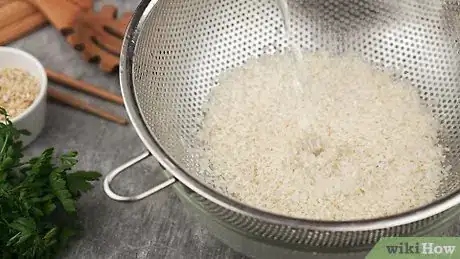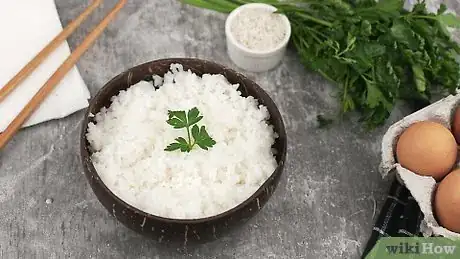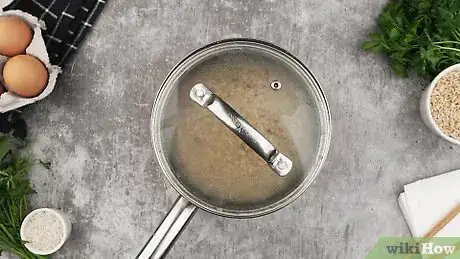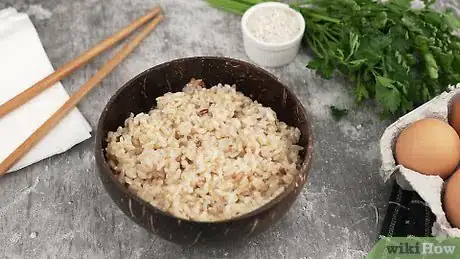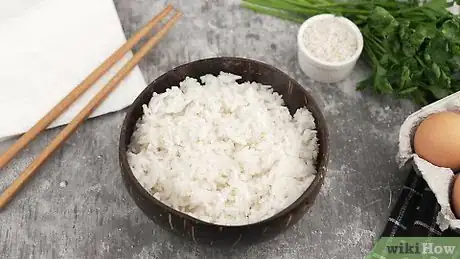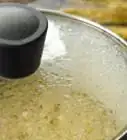This article was co-authored by JoAnna Minneci. JoAnna Minneci is a Professional Chef based in the Nashville, Tennessee area. With more than 18 years of experience, Chef JoAnna specializes in teaching others how to cook through private cooking lessons, team-building events, and wellness and nutrition classes. She has also appeared in numerous television shows on networks such as Bravo and Food Network. Chef JoAnna received Culinary Arts training from the Art Institute of California at Los Angeles. She is also certified in sanitation, nutrition, kitchen management, and cost control.
This article has been viewed 142,132 times.
Rice is one of those kitchen staples that can help round out a wide variety of meals. Whether you prefer white, brown, or basmati, rice can make a tasty side dish to any main course. But if you don't have a rice cooker, boiling rice on the stove top can sometimes be intimidating because it requires careful watching. Once you master the technique for boiling your favorite rice, though, you can whip up a pot in no time.
Ingredients
- 1 cup (195 g) medium- or long-grain white rice
- 2 cups (470 ml) water
- ½ teaspoon (2.84 g) salt
- 1 tablespoon (14 g) butter or oil (optional)
- 1 cup (190 g) medium- or long-grain brown rice
- 1 teaspoon (5 ml) olive oil or sesame oil
- 2 cups (470 ml) water
- 1 teaspoon (5.68 g) salt
- 2 cups (380 g) basmati rice
- 3 cups (705 ml) boiling water
- Salt to taste
Steps
Making Boiled White Rice
-
1Rinse the rice in cold water. Before boiling white rice, it’s a good idea to rinse it. That removes any dusty starch that might be on the rice so it doesn’t stick together when it cooks. Place 1 cup (195 g) medium- or long-grain white rice in a strainer, and rinse it under cold running water.[1]
- Rinsing the rice isn’t always necessary. Some rice may have more starch on it than others, though, so you may just want to get in the habit of doing it with every batch that you boil.
-
2Bring the water to a boil. Add 2 cups (470 ml) of water to a small saucepan, and place it on the stove at medium-high to high heat. Allow the water to heat until it comes to a roiling boil.[2]
- When you’re making white rice, use a use a 1:2 ratio for the rice and water. That means for every 1 cup of rice you plan to make, use 2 cups of water.
- As it cooks, rice expands so it’s important to use a pan that’s large enough for the amount that you’re making. In general, a 2-quart (2.5 L) pan is large enough for 1 to 2 cups of uncooked rice.
Advertisement -
3Add the rice and salt to the pot. Once the water comes to a boil, add the rice and ½ teaspoon of (2.84 g) salt and stir gently. Allow the pot to come to a gentle simmer.[3]
- You can also add 1 tablespoon (14 g) of butter or oil to flavor the rice and keep it from sticking together as it cooks.
- Follow the instructions on the package because it may be different for various kinds of rice and recipes.
- If you cook one and a half cups of rice with three cups of water, you can bring it to a boil and turn it off. Do not remove the lid. There will be fewer chances of overcooking the rice.
- If you use more than three cups of water, you may need to let it simmer for a while.
-
4Cover the pot and cook until the rice is tender. After the pot reaches a simmer, turn the burner’s heat down to low, and cover the pot with its lid. Allow the rice to cook for approximately 18 minutes. At that point, start checking its texture. When the rice is finished, it will be firm but not crunchy. You want it to be tender, so it’s okay if it’s somewhat sticky. However, make sure that you don’t cook it so long that it becomes gummy.[4]
- Don’t take the lid off the pot before the 18 minute mark. It helps trap steam that aids in the cooking process, so if you remove the lid, it may take longer for the rice to finish.
- If you don’t have a lid for your pot, use foil to cover it while the rice cooks. Just make sure to cinch the foil around the edges so the steam can’t escape.
- If there’s still water left in the pot when the rice is finished cooking, you should drain it. Just tilt it over the sink to allow the excess water to drip out.
-
5Allow the rice to sit in the pot for several minutes. Once the rice is finished cooking, turn off the heat but leave the rice in the pot with the lid on. Let it sit and steam for another 5 minutes to finish off the cooking process.[5]
-
6Fluff the rice with a fork and serve. Just before you’re ready to serve, take the lid off the pot and use a fork or spoon to comb through the rice and fluff it. Transfer the rice to a bowl or individual plates and serve.[6]
- It’s a good idea to allow the rice to sit for another 2 to 3 minutes after fluffing before you serve it. That gives it some time to dry out so it’s not too wet and sticky when you serve it.
Making Boiled Brown Rice
-
1Rinse the rice in cool water. Just as with white rice, it helps to give brown rice a rinse before boiling it. That helps remove any dust and grit that may be clinging to it. Place 1 cup (190 g) medium- or long-grain brown rice in a strainer or colander and rinse it under cool water.[7]
- Rinsing the rice before cooking can also improve its texture, so each grain is distinct and doesn’t stick to the others.
-
2Toast the rice in a pot. To bring out the nutty flavor of brown rice, you should toast it before boiling it. Place a 2-quart (2.5 L) pan on the stove, and heat 1 teaspoon (5 ml) olive oil or sesame oil in it over medium-high heat. Add the rice to the pan, and toast it until the rice is completely dry and the ends begin to look lightly toasted.[8]
- You can also tell when the rice is finished toasting when it begins to give off a nutty aroma.
-
3Combine the water and rice in the pot. After the rice has finished toasting, pour 2 cups (470 ml) of water into the pan, and mix in 1 teaspoon (5.68 g) of salt. The water will steam and bubble when you first add it because the pan is hot due to the toasting.[9]
-
4Bring the pot to a boil and reduce the heat. Leave the pot on the burner at medium-high to high heat, and bring the rice, water, and salt mixture to a complete boil. After the pot comes to a boil, turn the heat to low and allow it to reduce to a bare simmer before covering it with a lid.[10]
- Make sure not to cover the pot until the contents stop boiling completely.
-
5Cook the rice for 45 minutes. After you’ve covered the pot, allow it to cook on low heat for 45 minutes. At the end of the cooking time, uncover the pot and look to see if the rice has absorbed all of the water. Test the rice to see if it’s no longer crunchy too. It should be tender but slightly chewy when it’s done.[11]
- During the 45 minute cooking period, don’t uncover the pot. That will cause steam to escape, and the rice will need longer to cook.
- It’s okay if there’s a little water at the bottom of the pot when you check it after 45 minutes. If there’s more than 1 tablespoon (15 ml) of water, though, drain the excess into the sink.
- If the rice is still crunchy after 45 minutes, pour a bit more water if necessary into the pot and allow the rice to cook longer. Be sure to check on it in 10 minute intervals, though, until the rice is tender.
-
6Cover the rice and let sit for 10 to 15 minutes. When the rice is finished, remove it from the heat, and place the lid on the pot once again. Allow it to sit for approximately 10 to 15 minutes in the covered pot to get rid of some of its stickiness.[12]
- Allowing the rice to sit also helps it dry a little so it doesn’t seem as wet and freshly steamed when you serve it.
-
7Fluff the rice and serve. Remove the lid from pot, and use a fork or spoon to rake through the rice and fluff it. Place it in a bowl or on individual plates to serve.[13]
- Leftover brown rice can last between 3 and 5 days in an airtight container in the refrigerator.
Cooking Basmati Rice on the Stove
-
1Rinse and soak the rice. As with white and brown rice, you should rinse basmati rice before cooking it. Place 2 cups (380 g) basmati rice in a strainer, and rinse it under cold, running water to remove any dust or debris. Next, transfer the rice to a large bowl full of cold water and soak it for 30 minutes to an hour before draining it well.[14]
- Soaking the rice isn’t entirely necessary, but it helps make the rice softer once it’s cooked.
-
2Place the rice in a sauce pot and add boiling water. Transfer the rice to a heavy sauce pot that has a lid. Add a pinch of salt, and then pour 3 cups (705 ml) boiling water over the rice.[15]
- If you don’t have a lid for your pot, don’t worry. You can set a cookie sheet that’s large enough to cover it on top when the times comes.
- You can add as much salt as you like to taste. In most cases, ⅛ teaspoon (0.7 g) for each cup of rice is usually sufficient.
-
3Bring the pot to a simmer and then cover. Set the pot on a burner and turn the heat to medium-high. Allow the rice and water to come to a simmer, and just before it starts boiling and steaming once more, place a sheet of foil over the pot, pressing it all along the edges to keep the steam from escaping. Next, place the lid on top.[16]
-
4Cook the rice on low for 15 minutes and then allow it to sit. After you’ve covered the pot, turn the heat to low. Leave the rice to cook for approximately 15 minutes. When the time’s up, remove the pot from the burner, leave the lid in place, and let it sit for another 5 minutes to steam a bit longer.[17]
- During the 15 minutes when the rice is cooking, don’t remove the lid or foil to check on it. You’ll allow steam to escape, which can affect the cooking process.
-
5Fluff the rice and serve. After you’ve allowed the rice to steam for a few more minutes, remove the lid and foil from the pot. Use a fork to run through the rice and fluff it. Transfer it to a serving bowl and serve warm.[18]
Community Q&A
-
QuestionHow can I tell that the rice has been boiled the right amount while making biryani. It often ends up either overly cooked and sticky or hard.
 Community AnswerIt is better to check the rice after 6 minutes or so as a beginner to the dish. Just take one grain and break it to check if the rice is cooked or not.
Community AnswerIt is better to check the rice after 6 minutes or so as a beginner to the dish. Just take one grain and break it to check if the rice is cooked or not. -
QuestionCan I reheat boiled rice?
 Community AnswerYes, you can reheat boiled rice in a microwave. Reheat times will vary by microwave and the amount of rice, but try heating it for about a minute or a little less.
Community AnswerYes, you can reheat boiled rice in a microwave. Reheat times will vary by microwave and the amount of rice, but try heating it for about a minute or a little less.
Things You'll Need
Boiled White Rice
- A strainer or colander
- A 2-quart (2.5 L) pan with lid
- A fork
Boiled Brown Rice
- A strainer or colander
- A 2-quart (2.5 L) pan with lid
- A fork
Boiled Basmati Rice
- A strainer or colander
- A medium-sized bowl
- A medium saucepan with lid
- Foil
- A fork
References
- ↑ https://www.thekitchn.com/how-to-cook-rice-on-the-stove-44333
- ↑ https://www.thekitchn.com/how-to-cook-rice-on-the-stove-44333
- ↑ https://www.thekitchn.com/how-to-cook-rice-on-the-stove-44333
- ↑ https://www.thekitchn.com/how-to-cook-rice-on-the-stove-44333
- ↑ https://www.thekitchn.com/how-to-cook-rice-on-the-stove-44333
- ↑ https://www.thekitchn.com/how-to-cook-rice-on-the-stove-44333
- ↑ http://www.thekitchn.com/how-to-cook-brown-rice-113856
- ↑ http://www.thekitchn.com/how-to-cook-brown-rice-113856
- ↑ http://www.thekitchn.com/how-to-cook-brown-rice-113856
- ↑ http://www.thekitchn.com/how-to-cook-brown-rice-113856
- ↑ http://www.thekitchn.com/how-to-cook-brown-rice-113856
- ↑ http://www.thekitchn.com/how-to-cook-brown-rice-113856
- ↑ http://www.thekitchn.com/how-to-cook-brown-rice-113856
- ↑ http://www.thekitchn.com/how-to-cook-perfect-basmati-rice-cooking-lessons-from-the-kitchn-211157
- ↑ http://www.thekitchn.com/how-to-cook-perfect-basmati-rice-cooking-lessons-from-the-kitchn-211157
- ↑ http://www.thekitchn.com/how-to-cook-perfect-basmati-rice-cooking-lessons-from-the-kitchn-211157
- ↑ http://www.thekitchn.com/how-to-cook-perfect-basmati-rice-cooking-lessons-from-the-kitchn-211157
- ↑ http://www.thekitchn.com/how-to-cook-perfect-basmati-rice-cooking-lessons-from-the-kitchn-211157
About This Article
To make boiled white rice, rinse 1 cup of medium- or long-grain rice under cold running water to remove dust or excess rice. Bring 2 cups of water to a rolling boil, then add the rice and 1/2 tsp of salt. If you’d like, you can also add 1 tbsp of butter or oil to help prevent the rice from sticking. Bring the water back up to a simmer, then turn the heat to low and cover the pot. Allow the rice to cook for about 18 minutes, or until the water is absorbed and the rice is firm but not crunchy. Turn off the heat and let the rice stand covered for about 5 minutes before you serve it. Keep reading to learn how to make boiled brown rice!
